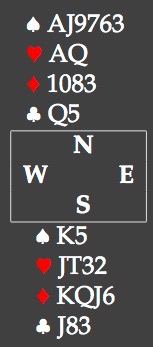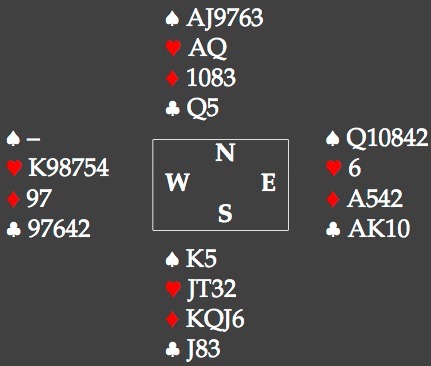 A hand from last Sunday. Team, all white. Partner opens 1♠, you bid 6-11 semi-forcing 1NT and 2♠
from partner. While you have a fit, your hand has very little
potential in a suit contract with all those secondary honnors and lack
of ruffing values, so you bid 2NT. Partner raises to 3NT. The opening
lead is a small heart (3rd/5th), you put up the ♥Q, small on your right. The obvious next move is to work on spades, so you continue with a small spade, small, ♠K and LHO discards a club. That is not good news, now what?
A hand from last Sunday. Team, all white. Partner opens 1♠, you bid 6-11 semi-forcing 1NT and 2♠
from partner. While you have a fit, your hand has very little
potential in a suit contract with all those secondary honnors and lack
of ruffing values, so you bid 2NT. Partner raises to 3NT. The opening
lead is a small heart (3rd/5th), you put up the ♥Q, small on your right. The obvious next move is to work on spades, so you continue with a small spade, small, ♠K and LHO discards a club. That is not good news, now what?
The national team competitions have started for the 2013-2014 season. For us, in the 2nd division, it still uses the same format as has been used for the last decade or two: 14 teams from, in our case, the eastern part of the country, play a full round robin of 24 board matches. The winner is promoted to the 1st division, the bottom go back to the regional competitions. The only difference is that the 25-5 VP scale has been replaced by the new 20-0 scale, but that is not going to matter.
At the national level, things have changed a bit. The national championship used to be contested by 12 teams. Those teams played a double round robin, then the top 4 played KO's over two weekends, Whoever won, was the national champion for a year. Simple and fair. With 16 board sets, the event took so 500 boards and 12 days of play to complete. That is in the same range as, for example, the US Spingold or Vanderbilt.
This year, the format has changed completely. It is probably close to impossible to explain it in words, so here is a diagram trying to explain it:
Yes, that is right, the round robin plus KO, has been replaced by 2 round robins, a bye, a qualifying KO, semi-finals, finals, and a relegation KO. I have several problems with this setup:
- It is highly complex, which is bad for publicity.
- The
first round robin is short, 11 instead of 22 matches, increasing the
probability that a good team misses out on the semi-finals. As a case
in point, this would have happened in Bali if the round robin phase
there had ended half-way.
- Apparently some players had complained about the length of the previous format. While this might be a valid argument, the new format does change much. As almost nobody can be certain of finishing 1st or 2nd, one still has to block 5 weekends in his or her agenda until the very last moment.
All in all, this doesn't sound like an improvement to me, more like an attempt to reduce a simple problem to a complex one.
And who devised this scheme? Officially, it comes from the tournament committee of the federation. The grapevine has it though that it was invented by one of well paid professional players, who thought he'll have the weekend of the quarterfinals off and could attend a well paid tournament elsewhere. Sorry, that is not an argument for me. We're dealing here with the national championship of one of the strongest bridge-nations on the planet.
Back to the 3NT hand. When LHO shows out on the first round of spades, you have to start on the red suits, in an attempt to set up 6 red suit tricks, plus the two spades you already have and hopefully a club in the process. Your ♦K is won by east's ♦A. East doesn't look to pleased with that. He continues with the ♣AK and a small one. That something he wouldn't do with 2 or more hearts, so he must be 5-1 in the majors, and something like 4-3 in the minors. Next you play a diamond to the ♦10 and cash a heart. As expected, east shows out.

Another diamond ad west shows out. The distribution is now an open book: west 0-6-2-5 and east 5-1-4-3. The last diamond brings east down to only spades, next a spade to ♠9 and east has to give the last 2 tricks to dummy. 3 diamonds, 3 spades, a club and 2 hearts bring your total to 9, for a 7 imp pickup when the other table doesn't bid more than 2♠ making exactly 2. The full hand on the right.
So far, we have played 5 matches, and our team (Onstein 4) is in second place. Full results can be found here. The gap with the number 1 team is only 1 VP, and there are still 8 matches to go.
